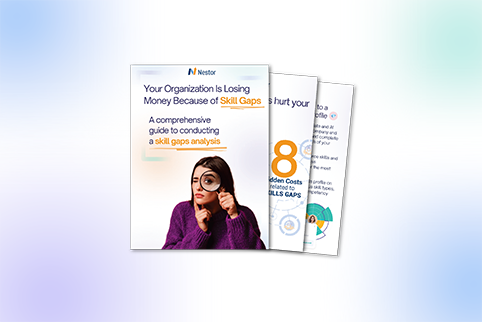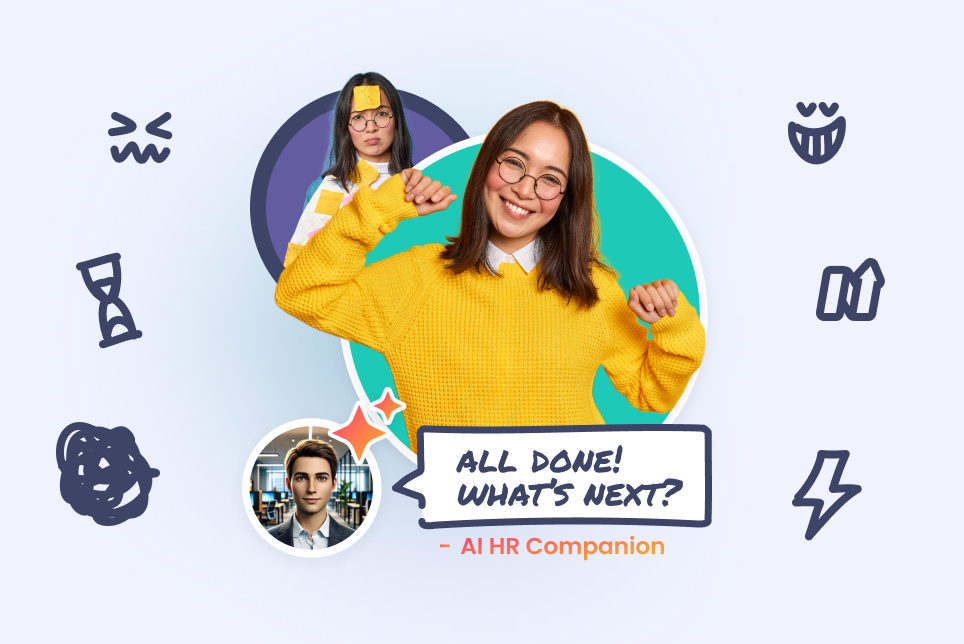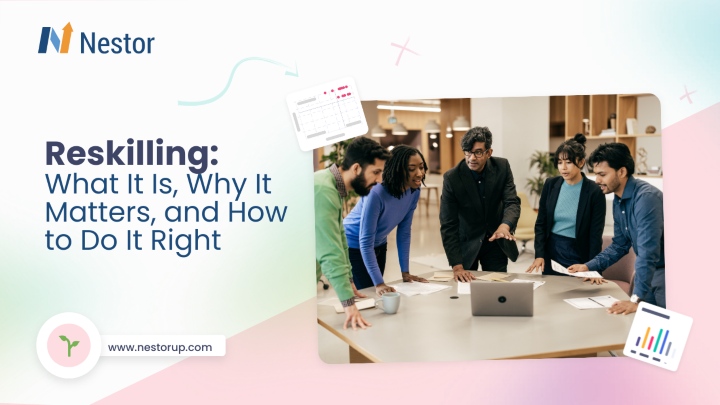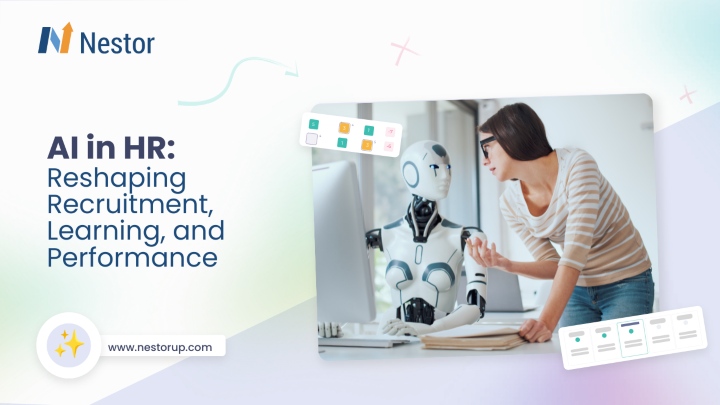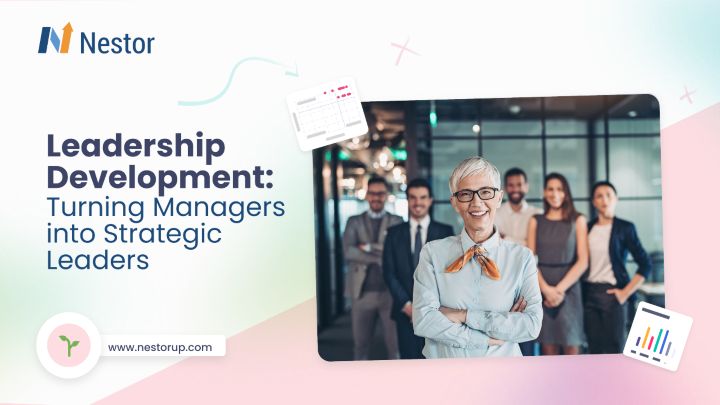Rewriting Performance with Skills: Key Takeaways from Deloitte’s 2025 Report
19 min read
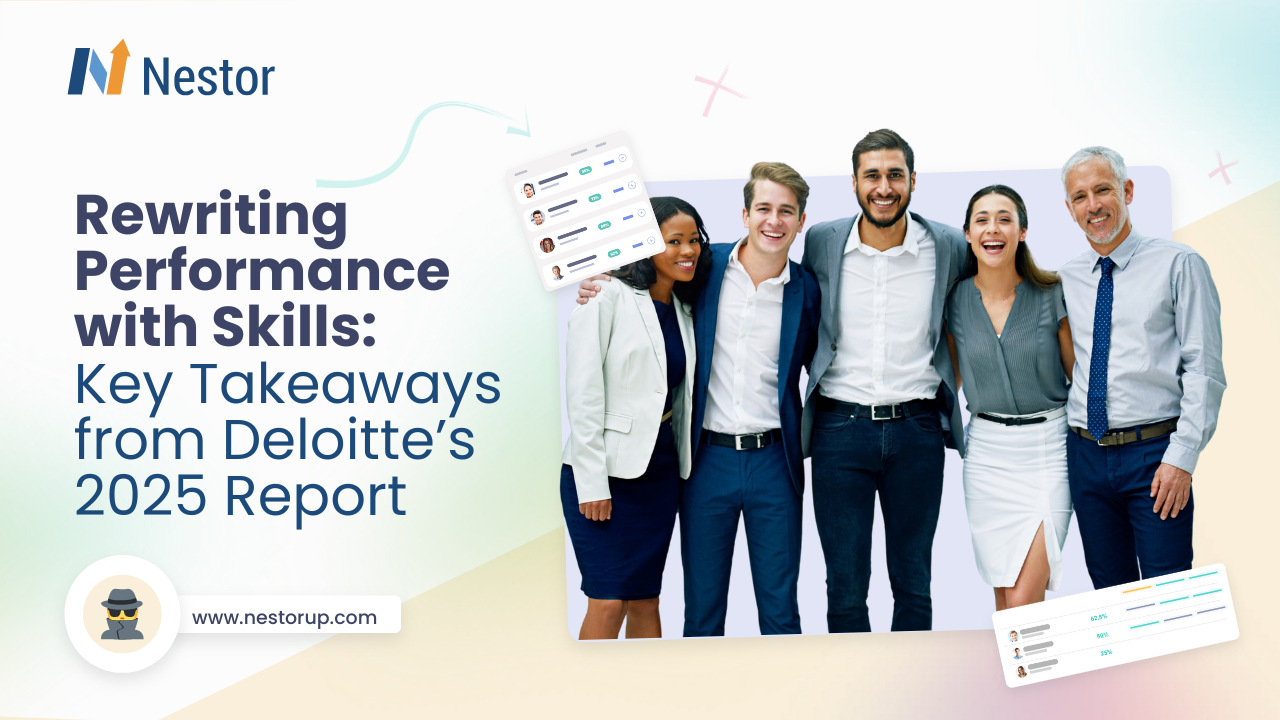
In 2025, the way we think about talent is being torn down, not rebranded, not fine-tuned. Rebuilt with skills.
People aren’t job titles. They’re not “resources.” They’re not interchangeable. And the systems that treat them that way? They’re collapsing under their own weight.
Deloitte’s 2025 Global Human Capital Trends report doesn’t try to polish the status quo. It throws a flag on the whole game. The message is clear: organizations can’t afford to manage people the old way, not if they expect performance, resilience, or innovation to follow.
This isn’t about choosing between hitting business goals or creating better employee experiences. That tradeoff was always false. When you design systems that recognize skills, value potential, and align people to meaningful work, performance takes care of itself.
The key is embracing the idea that human performance isn't a zero-sum equation between human and business outcomes, and it doesn't involve choosing workers over profit, or profit over workers.
— Deloitte’s 2025 Global Human Capital Trends
This isn’t a debate. It’s a redesign. One where skills are the core, and performance is the outcome. In this article, we’ll break down the most important takeaways from Deloitte’s 2025 report, and what they mean for any organization that’s ready to stop managing work and start designing for real performance.
Business Outcomes or Human Outcomes? The False Choice
When organizations face uncertainty, it’s almost instinctual to double down on numbers: cost, output, efficiency. Leaders focus on what they can track in spreadsheets. It feels safer. More objective. But that instinct is now part of the problem.
Deloitte’s 2025 Global Human Capital Trends report challenges a deeply embedded assumption in how most companies operate: the belief that business outcomes and human outcomes exist in tension. That investing in one means compromising the other.
The research shows this binary thinking is outdated, and actively harmful to transformation success.
Tensions between organizations and workers have always existed and are not going away. If anything, they can be expected to intensify as the impact of AI on work and workers accelerates. Moving forward, leaders will likely will need to take an approach to decision-making that puts human performance - balancing business and human outcomes - at its heart.
— Deloitte’s 2025 Global Human Capital Trends
In other words, you don’t have to trade off between people and performance. In fact, when you treat them as interdependent, you unlock both. That’s not just a nice sentiment. It’s backed by numbers. Organizations that integrate both people and performance into how they work are twice as likely to hit their transformation goals.
Still, most companies haven’t cracked the code. Only 6% of surveyed organizations say they’re making meaningful progress toward “human sustainability”. A concept that goes beyond engagement to include growth, purpose, and long-term well-being.
Why is this such a blind spot?
Because most organizations are still wired for a different era. An era where performance was synonymous with output. Where workers were measured by activity, not impact. And where the workplace was designed around rigid roles instead of dynamic capabilities.
But that system can’t keep up anymore. The pace of change is too fast. The workforce is too diverse in what it expects and values. And the talent companies are trying to attract won’t settle for workplaces that treat people like line items.
The disconnect is clear:
- Leaders say people are their most important asset.
- But in practice, business outcomes still take precedence in how decisions get made.
- And as a result, performance systems fall short on both fronts.
What’s the shift Deloitte is pushing for?
It’s not just a mindset change. It’s a systems redesign. One where human and business outcomes are engineered to fuel each other, by default, not by exception.
This means:
- Designing work in ways that give people autonomy, clarity, and purpose.
- Measuring performance not by how busy someone is, but by how much impact they generate, and how aligned that impact is to their strengths.
- Rewarding growth, not just output, so that learning and development become a natural part of everyday performance.
And yes, skills play a massive role in making this possible. Skills need to become the currency that flows through every system: hiring, deployment, recognition, mobility.
That’s how we move from short-term productivity to sustainable performance.
From Jobs to Skills. The Redesign Has Begun
The job is no longer the unit of work.
That’s the quiet revolution happening inside organizations today. Work is being unbundled, pulled apart into tasks, capabilities, and problems to solve. And in this shift, skills are emerging as the building blocks that actually make the system move.
According to Deloitte, 93% of surveyed leaders say that moving away from rigid job structures toward more flexible ways of organizing work is important, or very important, to their success. But here’s the gap: only 19% say their organization is ready to make that shift.
That’s a massive disconnect. One that’s holding back everything from agility to internal mobility to innovation.
Why the job-first model is breaking down
The traditional job architecture was built for stability. One person, one title, one set of responsibilities. But in practice, work doesn’t follow those rules anymore. Teams reconfigure constantly. Skills needed for one project might not apply to the next. And roles evolve faster than job descriptions can keep up.
Trying to plug new skills into outdated job frameworks is like installing a touchscreen in a rotary phone. The format itself isn’t built to adapt.
This mismatch creates real problems:
- Skilled employees get stuck because their capabilities don’t “match” their job title.
- Leaders can’t find internal talent fast enough, even when it already exists.
- Development pathways feel vague, disconnected, or irrelevant.
Just 19% of business executives believe traditional models of work are best suited to create value for workers and the organization. And 85% say that organizations need to create more agile ways of organizing work to swiftly adapt to market changes.
— Deloitte’s 2025 Global Human Capital Trends
The shift toward skill-based ecosystems
Some companies aren’t waiting around for legacy structures to catch up. Shell, for example, has started to build skill-based ecosystems, fluid environments where employees are matched to opportunities based on what they can do, not what their title says.
This isn’t just more efficient. It gives employees visibility into how their skills are valued, what growth looks like, and where they can go next.
And it gives leaders something even more valuable: clarity. Instead of managing headcount, they can manage capabilities. Instead of guessing who’s ready for what, they can use real-time data to make smarter decisions about deployment, development, and succession.
What matters now
This isn’t about getting rid of jobs entirely. It’s about loosening their grip on how we structure work. Skills offer the flexibility organizations need to adapt without starting from scratch every time the market shifts.
But that only works if companies treat skills as part of the system, not just as data points in a learning platform.
And that’s where we’re headed next.
Skills as the System, Not Just a Database
Identifying skills is easy. The hard part is making them actionable.
That’s the gap most organizations are facing. They’ve invested in skills frameworks, built catalogs, tagged roles. But when it comes time to make decisions, about staffing, development, promotions, those insights barely surface.
High-performing organizations are 22 times more likely to openly discuss strategies for how decisions will be made, nine times more likely to teach decision-making skills and capabilities, and seven times more likely to provide tools to support higher-quality decision-making than are low-performing organizations
— Deloitte’s 2025 Global Human Capital Trends
Turning skills into action
A true skills-based organization builds its workflows around capabilities, not just in hiring or L&D, but across the entire employee lifecycle.
This means:
- Matching people to work based on skill readiness, not role fit.
- Designing growth paths that adapt as the business evolves—not just tied to promotions.
- Deploying talent dynamically across projects, not just departments.
- Rewarding impact, not tenure.
Deloitte’s report highlights that despite the hype, only 16% of organizations use skills data to a significant degree when making workforce decisions. That’s the problem. The data exists. But it’s not flowing into the decisions that actually shape work.
AI-powered talent marketplaces: from stretch goals to stretch roles
The next evolution of skills systems is already here and it’s powered by AI. Talent marketplaces are no longer just tools for visibility or internal gigs. They’re becoming smart engines that actively grow your workforce.
With AI, companies can now:
- Place employees in stretch assignments that challenge them and build future-fit skills.
- Offer each worker a personal AI agent that acts like an intern, surfacing relevant learning, nudging action, and providing on-the-job coaching.
- Deliver feedback and guidance at scale, not just during performance reviews, but as a continuous loop.
AI-powered talent marketplaces can place everyone in stretch assignments, provide everyone with an AI agent that acts as a personal intern, and deliver personalized coaching at scale.
— Deloitte’s 2025 Global Human Capital Trends
This isn’t theoretical. Amazon, for example, uses AI coaches to provide real-time feedback based on aggregated experience data. That kind of system doesn’t just support employees—it scales capability across the entire organization.
Learning in context: experience, not content
Traditional learning still sits outside of work, separated from daily tasks and often detached from business priorities. But the most effective development is contextual.
Deloitte calls out several high-impact strategies:
- Upskill in context: Develop skills directly within the roles people are aiming for.
- Create micro-opportunities: like digital playgrounds or short-term projects, that allow workers to practice judgment and make real decisions in low-risk environments.
- Add reflective moments: experiences turn into long-term capability, not just short-term output.
These approaches don’t just check a development box. They accelerate real growth, because they embed learning where it matters: inside the work itself.
Tech that powers people
This shift also reframes the role of technology. Instead of using tools to just track activity, leading organizations are asking how tech can actively support human performance.
Organizations have the potential to create positive feedback loops in which technology investments better cultivate and support their people, who, in turn, create greater value with technology.
— Deloitte’s 2025 Global Human Capital Trends
That’s the real opportunity: to design systems where growth is continuous, learning is embedded, and performance isn’t something you manage. It’s something that emerges naturally from well-designed environments.
Redefining Performance
You can’t keep measuring modern work with outdated tools.
Most performance systems still revolve around output: did the task get done, how fast, how often. But that mindset was built for jobs where success was repeatable, predictable, and transactional. That’s not how most work operates today.
Work has changed, so has talent. People aren’t just delivering tasks. They’re solving problems, navigating ambiguity, working across teams, and learning on the fly. And yet, performance is still judged by volume over value.
That disconnect shows. According to Deloitte, 41% of the work people do doesn’t add real value. That’s nearly half of your workforce’s time spent on things that don’t move the business, or their own growth, forward.
The problem isn’t laziness. It’s that the system isn’t designed for meaningful contribution.
Leaders should make sure they’re considering the right data and be forthright in when, how, and where that data will be used in the decision. Focus on metrics that measure human outcomes, such as data on skills development and employability; emotional, mental, physical, social, and financial well-being; career stability and advancement opportunities; and societal impact.
— Deloitte’s 2025 Global Human Capital Trends
So what does better performance design look like?
It’s less about supervision, more about structure.
- Purpose is clear. People know how their work connects to outcomes, not just deliverables.
- Skills are visible. Roles flex based on what people can actually do, not what’s printed in their title.
- Impact is tracked. Metrics reflect quality, growth, and relevance, not just time spent.
This isn’t about making performance “softer.” If anything, it’s more rigorous because it forces leaders to define what real impact looks like, and creates a system where people are accountable for work that actually matters.
The traditional performance model assumes that output equals effort. But in a skills-first world, that equation doesn’t hold up. Someone might complete ten tasks, but if none align with their strengths or move the team forward, what’s the point?
The best organizations are shifting away from squeezing productivity and toward enabling potential. They recognize that when people are placed in roles that match their capabilities and given room to grow, they perform without being pushed.
Performance becomes a natural outcome, not a forced result.
Potential Is the New Predictor
Performance tells you where someone is. Potential tells you where they can go.
Most organizations are still stuck measuring the past, what someone’s already achieved, what roles they’ve held, what boxes they’ve checked. But in a world that’s changing faster than job descriptions can keep up, past performance isn’t enough.
The future of work demands a new lens: one that looks beyond experience and taps into capability.
And workers are demanding a change in approach. According to this year’s Global Human Capital Trends research, roughly 2 in 3 say it’s very or critically important for their organization to customize the design and experience of work and workforce practices based on worker skills, behavioral patterns, motivations, passions, and work styles.
59% say their organization values job experience and degrees over demonstrated skills and potential, and 66% say they would be more likely to be attracted to and remain at an organization that values and makes decisions based on their skills and potential rather than on jobs and degrees.
— Deloitte’s 2025 Global Human Capital Trends
This shift is subtle, but powerful. It moves talent strategy from reactive to proactive. Instead of waiting until someone proves themselves in a role they’ve already outgrown, forward-thinking companies start investing in adjacent and latent skills early, before the opportunity gap becomes a retention problem.
Spotting potential: not just for high-performers
Historically, potential was reserved for the top 5%. Leadership tracks. Fast lanes. Special programs.
That model doesn’t scale. And worse, it leaves most of the workforce invisible.
AI and skills intelligence now make it possible to democratize this process. When you can see what people could do, not just what they’ve already done, you unlock a whole new layer of agility:
- A customer service rep who’s already halfway to being a UX researcher.
- An operations lead with the systems thinking to shift into product strategy.
- A sales team member with adjacent skills in data analysis, ready to pivot.
These aren’t hypotheticals. With the right visibility, companies can build growth maps that make these transitions real, not just aspirational.
Development that’s tied to future needs
This shift isn’t about betting on “potential” in a vague, soft-skills way. It’s strategic.
Organizations are starting to:
- Map future capability needs based on where the business is headed.
- Assess adjacent skills to see who could evolve into those roles.
- Offer targeted development in role-relevant, real-time ways so people grow into their next role while still contributing in their current one.
It’s smarter talent planning, built around mobility, not attrition. And for the employee? It signals something big: we see you for more than your résumé. We see where you can go.
How Leading Companies Are Designing for Human Performance
Talk is cheap. Strategy isn’t.
While many organizations are still trying to retrofit new ideas into old systems, some have already made bold moves to redesign how people work, grow, and thrive, without sacrificing business outcomes. These aren’t fluffy culture plays. They’re practical, measurable changes that unlock capacity, improve retention, and drive performance.
Here’s how a few companies are actually doing it.
Molson Coors: Hiring for potential, not paper
Molson Coors scrapped résumés altogether for certain roles in Europe. Instead of filtering candidates by experience or education, they focus on motivation, behavior, and cultural fit. Applicants complete a task-based assessment and give a short presentation, like pitching their favorite brand.
We are interested in seeing your behaviors in action and how they will help you become successful at Molson Coors, giving everyone the opportunity to show their potential, regardless of background or experience.
— Molson Coors
This approach does more than shake up hiring. It removes artificial barriers, widens the talent pool, and brings in people with untapped potential, not just traditional credentials. That’s real inclusion in action.
Medibank: Redesigning the week for well-being and output
In 2023, Medibank launched a four-day workweek pilot using the 100:80:100 model: 100% pay, 80% hours, 100% expected productivity. But they didn’t just cut hours, they cut the wasted time. By eliminating low-value work, they gave those hours back to employees as “the gift.”
The results speak for themselves:
- Turnover intention and absenteeism dropped.
- Job stress decreased by 9.6%.
- Overall health improved by 13%.
- Productivity? It didn’t drop, it held steady.
This isn’t about working less. It’s about working smarter and recognizing that well-being isn’t a trade-off. It’s a performance driver.
Slack (Salesforce): The power of structured rest
Slack ran a two-week experiment encouraging employees to take regular, self-directed breaks during the workday. They could use the time however they wanted. Just pause. Reset. Breathe.
The outcomes:
- Focus improved by 92%.
- Stress management scores skyrocketed by 230%.
- Overall work satisfaction rose by 63%.
Even participants who didn’t take many breaks still saw benefits. The lesson? Reclaiming capacity doesn’t mean downtime. It means better output with less burnout.
Shell: AI that frees up human energy
Shell is using AI to transform inspection and monitoring across plants, pipelines, and renewable energy sites. Tasks that once required in-person inspections can now be handled remotely by drones and robots. That’s not about cutting people. It’s about upgrading their role.
Now, technicians can shift focus to more strategic, high-skill work. New jobs are also emerging, like annotating images to improve AI algorithms.
This is the ideal use of tech: not replacing people, but redesigning their role to be more impactful.
When our workforce is not empowered and fails to see how technology can help them be better at their work and their work be better for them, we don’t see the desired business outcomes.
— Shell Company
The pattern is clear
These companies aren’t just chasing trends. They’re building environments where people have space to think, grow, and contribute at a higher level. The systems are different, but the principle is the same: when people benefit, the business benefits.
Human performance isn’t about squeezing more from the same people. It’s about designing work, technology, and systems that allow people to do their best work, consistently and sustainably.
Building the Human Operating System
You don’t fix performance by training harder or tracking more. You fix it by redesigning the system people work in.
That’s what top-performing companies are starting to realize. You can’t squeeze adaptability, engagement, or growth out of a system that was built for repetition and control. The future demands something more dynamic, a human operating system that runs on skills, not roles, and centers performance around people, not process.
This isn’t a feel-good concept. It’s a strategic shift. And it requires structure.
Here’s the framework:
1. Inventory: What capabilities already exist?
Start by mapping what your workforce can actually do, not just job titles or formal qualifications, but real, observable skills.
Use tools like:
- AI-driven skills taxonomies
- Self-assessments + peer validation
- Skill signals from projects, learning data, and performance reviews
Don’t aim for perfection. Aim for visibility. You can’t mobilize what you can’t see.
2. Design: How is work structured around skills?
Stop retrofitting skills into jobs. Instead, break work into tasks, problems, and opportunities, then rebuild it around capability.
This means:
- Dismantling rigid job architectures
- Creating project-based deployment models
- Aligning work with strengths, not static roles
Think modular, not monolithic. Build flexibility into the structure.
3. Measure: What are you optimizing for?
Ditch activity-based metrics. Measure the impact of work, the growth of people, and the alignment between the two.
Redefine KPIs to include:
- Skills application rates
- Internal mobility velocity
- Capability development over time
- Human-centered metrics like energy, adaptability, and intent to stay
Performance is no longer about how much gets done. It’s about whether the right things get done, by the right people, in the right way.
4. Activate: How do you move from insight to action?
This is where most organizations stall. You have the data, you know the gaps, but the system doesn’t respond.
To activate the human operating system, you need:
- AI-powered talent marketplaces to dynamically match people to opportunities
- Learning ecosystems that support contextual upskilling
- Integrated platforms that feed skills data into hiring, deployment, rewards, and planning
Make movement easy. Let people see where they could go, what skills they need, and how to get there, then give them the space and support to move.
Final Thoughts
Performance doesn’t come from pressure. It comes from design.
That’s the core message of Deloitte’s 2025 report. Skills are the fuel, but the system is the engine. When companies shift from managing roles to designing for human potential, everything changes: how people grow, how teams move, and how results are achieved.
This isn’t about adding one more platform or launching another HR initiative. It’s about rethinking how work is structured, how talent is developed, and how success is defined.
If you’re still optimizing for output, you’re playing yesterday’s game. If you’re still making tradeoffs between business goals and human outcomes, you’re solving the wrong problem. And if you’re waiting for a perfect strategy before you start, don’t. The system you build today is the performance you get tomorrow.
Want performance? Invest in skills.
Want resilience? Build systems.
Want both? Design for human performance at scale.
The companies that make this shift now won’t just survive the next wave of change. They’ll shape it.



